Description
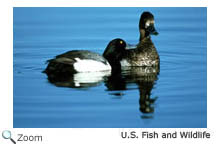 The lesser scaup is a small diving duck. It is 15-18 inches in length with a wingspan of 27-30 inches. It has a slightly pointed head, yellow eyes, and a grayish-blue bill with a small black tip. The male has a black chest and tail and gray sides. He has a purple head that looks black. The lesser scaup is a small diving duck. It is 15-18 inches in length with a wingspan of 27-30 inches. It has a slightly pointed head, yellow eyes, and a grayish-blue bill with a small black tip. The male has a black chest and tail and gray sides. He has a purple head that looks black.
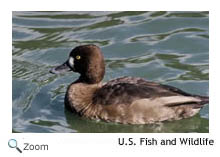 The female is brown and has a white band around the base of her bill. Both the male and the female have a short white stripe on their wings. The lesser scaup looks very similar to the greater scaup. The greater scaup is a little larger than the lesser scaup, its head is more rounded, and the black tip on the end of the bill is larger. The female is brown and has a white band around the base of her bill. Both the male and the female have a short white stripe on their wings. The lesser scaup looks very similar to the greater scaup. The greater scaup is a little larger than the lesser scaup, its head is more rounded, and the black tip on the end of the bill is larger.
Range 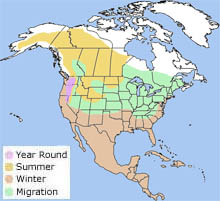 The lesser scaup breeds
from Alaska and western Ontario south to Minnesota, northern Colorado, and northern California.
It winters throughout the United States both inland and along the coasts. The lesser scaup breeds
from Alaska and western Ontario south to Minnesota, northern Colorado, and northern California.
It winters throughout the United States both inland and along the coasts.
| |
Habitat
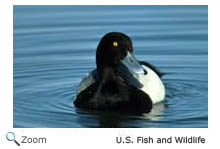 The lesser scaup
is found on freshwater marshes, lakes, ponds, and bays during breeding season. In the winter, it is found in saltwater, brackish, and freshwater habitats. The lesser scaup
is found on freshwater marshes, lakes, ponds, and bays during breeding season. In the winter, it is found in saltwater, brackish, and freshwater habitats.
Diet
The lesser scaup dives for
clams, snails, crustaceans, and aquatic insects. It also eats seeds and aquatic plants.
Life Cycle
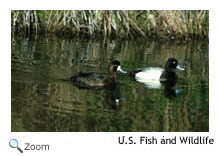 The female lays 5-13 eggs in a depression in the ground lined with grass and down. Nests are usually located close to the water. The male leaves when the female begins to incubate the eggs. The female incubates the eggs for 23-28 days. The chicks are precocial. Shortly after hatching, the female leads them to water where they can feed themselves. They can dive for food, but they can't stay under water for more than a few seconds. They are so buoyant that they pop right back up to the surface!
The ducklings fledge when they are 40-45 days old. The female lays 5-13 eggs in a depression in the ground lined with grass and down. Nests are usually located close to the water. The male leaves when the female begins to incubate the eggs. The female incubates the eggs for 23-28 days. The chicks are precocial. Shortly after hatching, the female leads them to water where they can feed themselves. They can dive for food, but they can't stay under water for more than a few seconds. They are so buoyant that they pop right back up to the surface!
The ducklings fledge when they are 40-45 days old.
Behavior
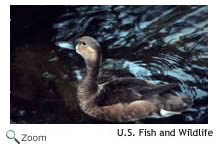 The lesser scaup will sometimes play dead when it is captured by a predator like the red fox. It holds still with its head stretched out, its eyes open, and its wings drawn into it body. The lesser scaup will sometimes play dead when it is captured by a predator like the red fox. It holds still with its head stretched out, its eyes open, and its wings drawn into it body.
|

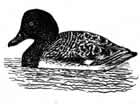


 The lesser scaup breeds
from Alaska and western Ontario south to Minnesota, northern Colorado, and northern California.
It winters throughout the United States both inland and along the coasts.
The lesser scaup breeds
from Alaska and western Ontario south to Minnesota, northern Colorado, and northern California.
It winters throughout the United States both inland and along the coasts.


